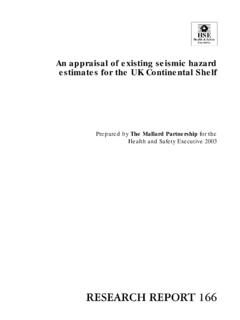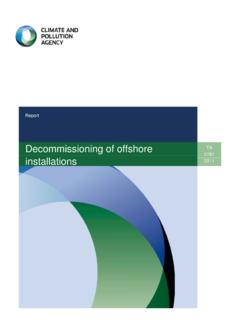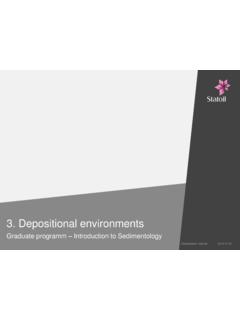Transcription of RESEARCH REPORT 409 - Health and Safety Executive
1 HSEH ealth & SafetyExecutiveHigh pressure, high temperature developments in the United Kingdom continental shelf Prepared by Highoose Limited for the Health and Safety Executive 2005 RESEARCH REPORT 409 HSEH ealth & SafetyExecutiveHigh pressure, high temperature developments in the United Kingdom continental shelf AW Glass Well Engineering Consultant Highoose Limited 5 Millden Road Cults Aberdeen AB15 9LJ In 2004 the UK Health & Safety Executive (HSE) commissioned RESEARCH in respect of high pressure, high temperature (HPHT) developments in the UK continental shelf (UKCS). Part 1 of the REPORT summarizes the scope for future HPHT developments possible in the UKCS. It is concluded that the price of HPHT exploration could be bigger than previously thought. Part 2 of the REPORT reviews the HPHT incidents and defines the associated Safety issues. Well control incidents are by far the most frequently occurring but there appears to be an increasing occurrence of incidents related to catastrophic failure of well tubulars and hangers manufactured from premium steels or alloys In Part 3 the engineering and management solutions implemented by the UKCS industry are reviewed.
2 Where appropriate the risk associated with specific technical measures and concepts is highlighted. In a separate section a number of future technical developments are discussed. In Part 4 it is concluded that although the UKCS industry is on the right track a number of issues will still need to be solved. Based on the discussions with stakeholders in a workshop a number of Joint Industry Type projects are identified, in addition to other issues that require attention. This REPORT and the work it describes were funded by the Health and Safety Executive (HSE). Its contents, including any opinions and/or conclusions expressed, are those of the author alone and do not necessarily reflect HSE policy. HSE BOOKS Crown copyright 2005 First published 2005 All rights reserved. No part of this publication may be reproduced, stored in a retrieval system, or transmitted in any form or by any means (electronic, mechanical, photocopying, recording or otherwise) without the prior written permission of the copyright owner.
3 Applications for reproduction should be made in writing to: Licensing Division, Her Majesty's Stationery Office, St Clements House, 2-16 Colegate, Norwich NR3 1BQ or by e-mail to ii Acknowledgements The author is grateful for the opportunity and time given by industry representatives and experts to discuss HPHT related matters and for the contributions, comments and suggestions received from: Grady Ables Total Fred Algie HSE Jules Borm Shell Jan Brinkhorst Frontier Trevor Butler Nexus Graham Carson Baker Frank Close Chevron Margaret Copland HSE Jim Cowie BP Norman Day BP William Gill Talisman Alan Humphreys Total Philip Imperiale Shell Matt Inglis Vetcogray David Jamieson Cameron Eric Low Nexus George Lorgen Baker Alf Massie Vetcogray Mike Marray Retired ex Shell Mike McLean BP Richard Milton-Worssell Dti Ivor Palmer ConocoPhillips Chris Robins HSE David Scott HSE Dave Seymour Shell Clint Smith ConocoPhillips Bruce Tunget ConocoPhillips Fraser Tavendale Talisman Bill White Nexus Duncan Watt Nexus David Wilson Nexus Dave Woodland Shell Claas van der Zwaag PSA iii iv CONTENTS Executive SUMMARY.
4 VII XI PART 1 - FUTURE HPHT DEVELOPMENTS IN THE UKCS 1 INTRODUCTION .. 1 2 PROSPECTIVE 1 3 FIELDS AND DISCOVERIES .. 24 PROSPECTS .. 2 5 FUTURE EXPLORATION DRILLING 26 FUTURE FIELD DEVELOPMENT 2 PART 2 - HPHT WELL Safety ISSUES IDENTIFIED TO DATE 1. INCIDENTS ON THE 5 5 Control of unplanned influxes or flows: 6 Failures of blow-out preventers and ancillary 8 Detection of 9 Mechanical failures of a Safety critical Uncontrolled 13 2. HPHT INCIDENTS IN OTHER 13 3. PART 3 - HPHT WELL ENGINEERING AND MANAGEMENT SOLUTIONS 1. 17 2. RISK 17 3. INDUSTRY SOLUTIONS TO 20 Well 20 Foundation and 20 Sub sea 22 Intermediate casing 22 Reservoir Drilling into the prospective Well 24 v Depleted 25 Wellhead hangers and Material 26 Seal Production Material 27 Supply and installation 28 Commissioning and Operational 29 Killing 30 Sand 31 Water production and 31 Team 32 Quality assurance and 33 Response to 34 4.
5 FUTURE TECHNICAL 34 Managed pressure 34 Constant pressure 35 Borehole temperature 36 Expandable 37 Horizontal borehole 37 Insulated production 38 New 38 Deeper HPHT 38 HPHT wells in deep 38 PART 4 CONCLUSIONS AND RECOMMENDATIONS 39 41 45 46 vi Executive SUMMARY In 2004 the UK Health & Safety Executive (HSE) commissioned RESEARCH in respect of high pressure, high temperature (HPHT) developments in the UK continental shelf (UKCS) with the objective to: RESEARCH the full range of HPHT developments possible in the UKCS. Define the full range of Safety issues associated with HPHT developments to date. Review the competence and validity of solutions implemented to date. Identify any significant areas of uncertainty and sensitivity. Prepare a recommendation on the potential for a Joint Industry Project (JIP) to address any areas of significant uncertainty identified.
6 The Yet-To Find HPHT reserves have increased with a factor 3 to 6 since 2001. In a current study the Department of Trade and Industry (Dti) will attempt to put a more accurate figure to that estimate but there seems little doubt that the prize of HPHT exploration could be bigger than previously thought. Using the Dti definition some 227 wells drilled in the UKCS in the period 1987-2003 were identified as HPHT wells. To identify the HPHT Safety issues a comprehensive search of the HSE databases was carried out. On basis of the information obtained from 130 HPHT-related well incidents and the scant information about HPHT problems encountered in other areas, a number of apparent Safety issues and uncertainties have been identified: Well control incidents are by far the most frequently occurring of all HPHT well Safety concerns although the hazard related to kick incidents is limited.
7 In the UKCS the probability that well control problems will be encountered in a HPHT well has been successfully reduced from more than 45% to about 17%. The number of incidents involving blow out preventers and ancillary equipment is low. These failures in combination with well control incidents could have catastrophic consequences. Some potential Safety issues with perforating and production packers reported in other areas of the world have not (yet) become apparent in the UKCS. It is possible that this will become a future problem. There appears to be an increasing occurrence of incidents related to catastrophic failure of well tubulars and hangers. In most of these cases the failed equipment was manufactured from premium steels or alloys. In most - but not all - cases the root cause of the failure has been attributed to metallurgical flaws. There is no obvious correlation between the specific metallurgical problems and it is believed that there may be a common contributory cause that has not yet been identified.
8 The hazard related to well integrity failures of HPHT production wells is very significant. vii The design and construction of a HPHT well as any other well -- needs to comply with the general duty of the Offshore Installations and Wells (Design and Construction, etc) Regulations 1996 (DCR) Operators have demonstrated that this is generally possible with the available materials, equipment and technology. However an increased risk of failure continues to exist as a result of the: High stress environment both tension and compression High operating temperatures High temperature gradients in the well especially near surface. High-end metallurgy susceptible to specific environments Chemical activity of well fluid components enhanced by the high temperature Massive initial flow rates of most wells Narrow margin between the boundaries presented by loading uncertainties and material property variations.
9 The validity and competence of the technical solutions implemented to date is reviewed under two separate headings: The Well Construction and Maintenance Operations The main issue is the high-pressure regime that exists in the prospective zone and more specifically the narrow margin between the required borehole pressure to control the reservoir pore fluid pressures and the allowable pressure to retain borehole competence. Operators are employing the following methods to prevent well control problems: Accurate recording of minor influxes from detailed measurements of flows and rig movements. Using PWD equipment to obtain complete information on the ECD at any time. Employing fingerprinting techniques to demonstrate to the rig personnel the correct procedures for minimizing pressure surges. Refining the knowledge of jack up movements in deep water. In addition sophisticated pore pressure predictions are carried out during well planning to design an optimum drilling control programme that will avoid loss of borehole competence.
10 The latter has a high priority as kick and loss situations are agreed to be the most hazardous. The problem of well control is amplified when there is a need to penetrate partly depleted reservoirs within the overpressured sequence. The available method involves borehole strengthening by selective pore blocking. It is concluded that the industry is on the right track to keep the HPHT well control risk as low as reasonably possible. The Health & Safety Executive believes that the frequency of kicks can be reduced further by continued close attention to the available pore/frac pressure window for each individual well. It is expected that development and eventual application of some potential new techniques may also assist in reducing the kick incidence. The Quality of the Well Construction During production, HPHT well constructions have given rise to the concerns about the following hazards: Catastrophic failure of well tubulars and hangers Failure of sealing elements Inability to contain the gasbearing Hod and Frigg Chalks Erratic well growth viii Inability to withstand reservoir compaction Inability to inject chemicals for continuous downhole scale inhibition Many of above Safety concerns involve the loss of one barrier from the well control arrangements.

















